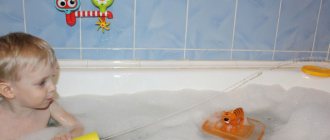What to do with a 2 year old child at home: 15 options
What kind of activity can you come up with for a two-year-old child so that he can play quietly for at least an hour?
And so that time passes profitably? This problem is familiar to many parents. Fortunately, at two years old, a child still knows little about the world around him, so it’s quite easy to surprise him. On the other hand, if the baby habitually reaches for the parent’s tablet, getting his attention will not be so easy. In addition, children 2-3 years old require adults to participate in the game, following them with a kind of “tail”. But mom and dad are also living people, and they want to be a little quiet. There is only one way out - to teach the baby to play independently. We hope that our tips will help you find some time for relaxation or urgent matters.
Constructor
It is best to have two different sets with large and small parts (but in accordance with the age! Remember that very small parts are not suitable for small children - they can swallow them). Let your child play them one at a time, removing one of them from visibility. Thus, the baby will think that he was given a new toy and will play with it with great interest.
2.Mystery box
Collect various small things in a large box: dried beans, buttons, shells, glass marbles, old calendars, etc. Make sure that all these objects are large enough so that the child cannot block his airways with them. Usually children study the contents of such a box as if spellbound. There is another version of this game: offer to transfer things from the box into small containers and back.
Money box
Take a box of rolled oats or other cereal and make a slit in one of the walls. Instead of coins, it is better to choose large buttons. Show your child how to squeeze “coins” into the “piggy bank.” The baby will be busy for at least 40 minutes.
Drawing
Drawing is a very useful activity for speech development. Children, of course, love to create their masterpieces exactly where they are not needed. Rather than worry about repairs, it’s better to give your child a roll of any cheap or old wallpaper to use as a canvas. Experienced parents advise hanging the roll directly on the wall so as not to deprive the little artist of his favorite vertical space.
Magnets
There are bright multi-colored magnets on almost every refrigerator. So why not hang them low so your child can play with them. Tested: kids are happy to take them off and put them back on.
Books with reusable stickers.
The more stickers your child has, the more interesting the game will be. In such books, the tasks are usually very simple, and parents need to be shown a couple of times how to do it so that the child can continue to play independently.
Water games
You can play while bathing, or you can pour water into a small basin. Give your child two or three containers, and he will pour water from one to another. You can fold a paper boat and send it sailing: show your baby how to blow so that it floats in the right direction.
Colored rice
For this game you need a large plastic tray (preferably bright), rice and food coloring (dyes for Easter eggs are suitable). Color the rice, dry it and place it in plastic containers. Place rice on a tray and show your baby how to draw different pictures with his finger.
Housework
Often the best way to keep a young child occupied is to let him help you with household chores. Children love to watch and imitate adults. Of course, you will have to redo some things later, but nevertheless, it's worth it. Give your child a small broom, ask him to sweep the floor, collect toys, offer to wipe plastic food containers with a towel, wipe off dust, take clothes out of the washing machine, etc. This way, you will kill two birds with one stone: the child will learn new useful skills and expand his vocabulary , and you will get a wonderful assistant.
Cook together
Of course, you should not give your child sharp knives or allow him to approach a working stove, but you can assign other safe operations, for example:
- wash and dry vegetables;
- put already chopped tomatoes or cucumbers in a salad bowl or slices of bread on a plate;
- give you sugar or salt with a spoon, etc.
The main thing is to be nearby and watch what the child is doing.
Modeling
You can sculpt from plasticine or salt dough (the most budget option). Show your child basic techniques, such as how to sculpt a dog or other animal. While he sculpts, you can work a little or quietly drink tea. The most successful crafts made from salt dough can be dried and painted.
Boxes
If you have ordered something from online stores, then you probably have a lot of boxes of all shapes and sizes at home. Just like for cats, baby boxes are incredibly attractive. Firstly, you can build an entire house from a large box; all you need is paint and scissors. Secondly, from the box you can make a wonderful garage for all your cars or a bedroom for dolls and soft toys. Thirdly, you can throw a ball into a box, like throwing a basketball into a basket... In short, there are a lot of ideas.
Fishing
Pour water into a small basin, put small toys in it, and give the child a slotted spoon or a spoon with holes as a fishing rod.
Puzzles
You can buy them at a stationery store or make them yourself. This is not at all difficult: stick a bright picture with a large pattern onto thick cardboard and cut it into 2-3 parts. First, show how to fold, then just check whether the child does everything correctly or not.
Laces
Like puzzles, such games can be bought, or you can make them yourself, and the child himself can cope with this task. Give him thick colored cardboard, bright laces and show him how to punch holes with a hole punch. Let your child connect the resulting parts in any order or give simple tasks, for example, threading a lace into a green or yellow element.
As you can see, in order to keep a two-year-old child occupied at home, no special invention is required. The main thing is to be patient. The reward will be some free time that you can spend on yourself.
games with a two year old child at home
Dear bb-shki. Our little kids are always ready to get dirty like piglets. Unfortunately this cannot be avoided.
But I think that each of you has an irreplaceable assistant for this, a washing machine.
It happens that she begins to be capricious like a child and does not want to listen to you. For such cases, there are special nannies, a washing machine repairman, which is what I am. I would like to invite you to read the article on how to turn children from dirty to neat, and my services. Come to my group https://vk.com/bytovoymastr, where you will learn information on how to care for her so that she is capricious as little as possible and does not hit the floor with her fists.
Call a specialist nanny at home, get discounts of up to 10% plus 5% if you have many children.
I wish you and your children good health and joy.
10 WAYS TO TEACH YOUR CHILD TO CLEANNESS AND ORDER
Contents: Where to start? Teaching order to a 2-3 year old child
Teaching order to a 5-8 year old child
We teach order to a child aged 9-14 years
A radical method of teaching order
Some advice for parents
Conclusion
Any mother dreams of raising her daughter to be a real housewife, and her son to be a neat and clean person. But how to teach a child to be tidy if the baby likes to throw toys around and doesn’t even think about cleaning up after himself? This question, of course, is not easy, but it is worth considering that all children are a little sloppy. How could it be otherwise? Playing in the sandbox, drawing, noisy home entertainment - all this requires enormous energy expenditure and absorbs all attention. A child who is captivated by the game is not able to keep order. Nevertheless, it is possible to make a clean girl out of a baby (in the good sense of the word). How? Read on. Where to begin? First of all, it is worth saying that young children are very susceptible to the influence of their parents. At the age of 3-4 years, kids tend to copy mom and dad in almost everything. For them, parents are an unquestioned authority, a role model, an ideal. This should be used to the maximum if you want to accustom your baby to cleanliness and order. Use your example to inspire your child to clean. Together, put things in their places, wash the dishes, put away toys after noisy games. With an older child, you can even wash the floor or vacuum the carpets. Remember that if you yourself do not like cleanliness and do not strive to maintain it, it is at least unfair to demand this from your baby. You can also give the following advice: never reprimand your child if he does something wrong, and encourage any initiative (washing dishes, wiping dust) with praise and delight. You can often see the following picture: a little daughter tries to wash the dishes herself, but it turns out badly - there is a coffee residue left somewhere on the cup, somewhere the foam has not been washed off the plate, the floor around is splashed with water. Mom, wanting to do everything faster and more accurately, takes the sponge from her daughter and washes the dishes herself. This behavior is fundamentally wrong. It will only discourage the baby from getting involved in cleaning in the future. We teach a 2-3 year old child to be orderly. It is at this age that it is advisable to begin teaching cleanliness, since for children the parent's word still remains the law. It is very easy to instill good habits and useful skills at 2-4 years of age. Encourage your child's initiative. This has already been mentioned above. It only remains to add that any attempt by your child to help you with the housework should not go unnoticed. At first, you shouldn’t even try to explain to your baby what he’s doing wrong. Don't give your little one difficult tasks. It’s clear that cleaning the floor is an impossible task for a two-year-old toddler, but he can handle cleaning the toys in his room without difficulty. The main thing is to tell your child in advance (or better yet, show him) what should be where. Teach order in a playful way. “Build” a house for cars, make a “kindergarten for dolls.” Bring a fairy tale into everyday life, and then it will be much more interesting for your baby to keep things clean. Teaching a 5-8 year old child to be orderly If in early childhood you laid a “good foundation”, then at 5-8 years old the child will consciously begin to strive for cleanliness and order. He already knows how to put away toys, wipe dust, wash dishes, it’s time to move on to more complex tasks. But since at this age children no longer consider cleaning an entertaining activity, conflicts may arise when the child refuses to perform one or another duty around the house. Don't get annoyed, but follow the rules below. Make a list. Write down on a piece of paper what your child can do. A sample to-do list for children 5-8 years old: wash the dishes; remove toys; dust your room; make the bed; wipe the bathroom mirror; clear the table after dinner; change the litter in the cat's litter box/sawdust in the rodent's cage; To water flowers; take out the trash. Don't burden your child with work. Remember that the child is not a housekeeper or a cleaner. There is no need to constantly demand help from him in household chores. It’s better to give him several basic tasks that he must complete during the day, when he has time for this. Never do your child's work. If he should dust but doesn't, remind him often of his responsibilities, but don't do it all yourself. Teaching a 9-14 year old child to be orderly All children at this age are rude and picky. Cleaning is clearly not something they would like to do. Nevertheless, learning to order is possible even at this difficult age. Let's make a reservation right away that it is too late to START accustoming a child to order at this age. Theoretically this is possible, but in practice the result is not always successful. Children, on principle, do not want to clean, even if they see that cleaning is really required. Define the task clearly. Keep your emotions and subjective assessments to yourself. The child must receive clear instructions for action. For example, instead of “Even a dog won’t eat from such a dirty floor!” say “The floor should be cleaned by this evening.” Motivate. Make the child want to clean up himself. Perhaps he himself will get tired of living in a dirty room, but is it really worth waiting for this moment? It’s better to create comfortable conditions for him to clean (while washing dishes, he can listen to music; while wiping dust, he can watch TV). Don't ridicule or teach. What teenagers don't like most is being made out to be small and stupid. A radical method of teaching order Not all psychologists will agree with this method. But it really works! If a child does not want to “understand” ordinary persuasion and requests, many mothers decide to take extreme measures. They set a condition: if you don’t put things away in your room, then everything that is out of place will end up in the trash can. Most children think it's a bluff, but the important thing here is to actually fulfill your promise. Even if we are talking about quite expensive things. Next time, your child will think three times before leaving a mess in the room. A few tips for parents From childhood, instill in your child a sense of responsibility for cleanliness, as well as respect for the work of others. Agree, if the baby swept the floor and spent a lot of effort on it, he is unlikely to want the floor to be dirty with dirty shoes. Don't act alone - involve your family in instilling in your child a love of cleanliness. And, on the contrary, do not let grandmothers do everything for the child. Let everyone in the family have their own responsibilities at home. The child should not have a question: why should I clean, but dad doesn’t do anything? The biggest mistake parents make is punishing for untidy toys. This method will not give anything, much less teach the baby to be in order. Conclusion Start teaching your children order as early as possible. At 2-3 years old, the ideal age for training begins from a psychological point of view. Do not punish your child, but praise him for any initiative. And, of course, try to be a role model for him. PS How to raise a happy child? How you raise your child will determine how happy he can be when he grows up. Many children receive psychological trauma in childhood, which their parents unintentionally inflict on them; they are unable to reveal all their talents, since their upbringing was such that the child grew up closed, unable to believe in himself or express his emotions. Psychologists all over the world are not sitting idle, trying to correct the mistakes of parents in order to restore to an adult child the ability to enjoy life and be happy. We sincerely recommend reading the free book “Happy Child”, here is the link to the book: Happy Child Useful and enjoyable reading. The book has already been read by hundreds of people and only positive reviews.
Source: https://agushkin.ru/vospitanie/kak-priuchit-rebenka-k-poryadku.html
I wish you and your children good health and joy.
Games for children 2 years old
Games for developing correct behavior in two-year-old children
Peculiarities of behavior of children at 2 years old
Children under two years old react vividly to the appearance of bright things in their field of vision. New objects attract their attention by their external characteristics - color, size, as well as the sound they make. The child’s attention itself is short-term and unstable.
Children react very sensitively to an adult’s voice, its volume and emotional coloring. They understand speech addressed to them, even if it contains complex sentences. They indicate the location of familiar objects, remember the road along which they have walked or ridden in a stroller many times.
Keeping in mind the peculiarities of the mental development of children of this age, try to establish a dialogue with the child when he begins to act up.
Squat down, look your baby in the eyes and say in a calm, confident, not loud voice that now you cannot do what he wants, because, for example, you need to go in a completely different direction, for example, to the store or turn off the TV in the next room. Promise that after this you will play with him. Then immediately try to distract him from sad thoughts: “Oh, look what (who) is there?! How big (red, beautiful) he is!”; “Help me, please, hold my bag (jacket, toy)”; “Let's go check if there is a big truck near our house?”; “Is your car still lying in the corner? Let’s go and have a look soon”; “Did we turn off the TV?” The main condition is to speak quickly, emotionally, without giving the child the opportunity to express dissatisfaction. Then keep your baby busy with play.
If suddenly the whimsical one doesn’t want to stop making noise and start obeying, and this, unfortunately, happens, there is only one thing left to do - take him by the hand and lead him away, not paying attention to his reluctance and resistance.
Games for switching attention
Bubble
Location. At home and on the street.
What is necessary. A “soap bubbles” toy or liquid soap diluted in water.
How to play. Blow soap bubbles yourself or let your child blow them. Then catch the bubbles.
Note. After playing, wash your hands to avoid getting soap in your eyes.
Zoo
Location. At home and on the street.
How to play. Encourage your child to imitate animals: “Look, the bird has flown. How do birds talk? We flew like birds!” You flap your arms and wings and chirp. “Let’s bark like dogs: “Woof-woof-woof!”, Let’s run after the cat! And now I’m a cow: “Moo-oo,” I’ll gore you.” We make horns - we put our index fingers to the head, now you can butt. Also try to imitate, for example, a frog (croak while squatting), a cat (meow while crawling on all fours), a duck (quack), etc.
Catch-up
Location. At home and on the street.
What is necessary. A space free from things potentially dangerous to the child (easily breakable, with sharp corners) and not cluttered with objects, furniture...
How to play. It is not necessary to tell your child that you want to play catch-up with him. You can say the following phrase, and the game will arise on its own: “And now I’ll catch up with someone, I’ll catch someone. Well, run away quickly! I'll catch up, I'll catch up, I'll catch you, I'll catch you! I caught you, ah!” Change roles, first you catch up, then the child runs after you: “Catch up with me, look, I’m running away!”
Shagalki
Location. At home and on the street.
How to play. “Let’s not just walk with you, but walk in different ways. Look how I can do it, repeat after me!” Walk like soldiers on the parade ground, without bending your legs. Or pretend to be a horse and walk with your knees high. Alternate steps: one - as soldiers walk, the other - imitating a horse.
Come up with your own options for steps - sideways, obliquely, etc.
Locomotive
Location. At home and on the street.
How to play. “Cling to me, I am a locomotive, and you are a carriage. Go! Chug-chug-chug, toot-too!” Then give your child the opportunity to be a locomotive and carry you.
Games to relieve negative emotions
Football player
Location. At home or on the street.
What is necessary. Ball of any color and size.
How to play. Even hesitantly walking children love to kick something. Place the ball at the child's foot. Supporting the little one with one hand so that he doesn’t fall, grab the football player’s leg with your other hand and help him hit the ball. After a sufficient number of training movements, the child will be happy to hit the ball on his own.
Catching up around
Location. At home.
What is necessary. Large toy, chair.
How to play. Catch up with each other by running around a toy or chair.
Ball games
Location. At home.
What is necessary. Ball of any color and size.
How to play. 1. Sit so that you can roll the ball to each other. Game option: sit opposite the wall with your child and take turns throwing the ball at the wall. You won’t have to get up once again to catch a rolled ball.
2. Throw the ball to each other, trying to catch it.
Charger
Location. At home.
What is necessary. Musical accompaniment.
How to play. Perform simple movements with your child to the music: walk in place, wave your arms, stretch your arms up, squat, spin or run around an object.
Hide and seek
Location. At home.
How to play. One of the adults hides, the other says: “Where is mom? Well, look for your mother, let's look together. Found! Now you hide. Rather, while mom doesn't see. Sit quietly. Mom, where is Maxim? Of course, you can play together with your child.
Master lomaster
Location. At home.
What is necessary. Cubes.
How to play. Build towers and houses from cubes, then destroy them, saying together: “Bang!”
Master craftsman on the street
Location. On the street.
What is necessary. Molds for sand and scoop.
How to play. Make Easter cakes out of sand, then level them with the ground, pronouncing “zh-zh-zh” or any other sound.
Slide downhill
Location. On the street.
What is necessary. Slide.
How to play. Invite your child to ride down the slide: “Let’s go for a ride!” It will be fun and interesting. Come on, show me how to slide down this slide correctly.”
Bounce
Location. On the street.
What is necessary. A chair, slide, ladder or any other elevation.
How to play. Place your baby on an elevated position. Almost without touching the child, hold him: “Jump into my arms, I will catch you!” Children don't know how to jump yet, but the baby will step towards you.
Of course you will catch the child. Next time, move your hands a little further, then even further, then take half a step away. Just don’t get carried away, there’s no need to risk the child’s health.
Games and activities that build positive behavior patterns
Listening to melodic music, children's songs, lullabies
What is necessary. Audio media with corresponding melodies.
How to play. Turn on the music and be close to your baby. While listening, exclude active games.
Story by picture
What is necessary. Brightly illustrated books, magazines, postcards, albums with reproductions of paintings.
How to play. Sit next to your child and leaf through the pages of books, naming the objects drawn and telling what is shown in the picture. Pay special attention to those illustrations in which someone helps someone: “Look, the duckling helped the chicken. The chicken did not know how to swim, but the duckling taught him to splash in the water. Well done duckling!”
Finger massage
How to play. Take the child in your arms or sit next to you. Start stroking and massaging each of your baby's fingers. Talk to him in a quiet, calm voice, you can recite poems and nursery rhymes.
Who is this?
What is necessary. Any toy
How to play. Carefully examine the toy with your child, saying: “Who (what) is this we have here? Chanterelle (pyramid, car). She has legs (rings, wheels), she is so fluffy (hard, bright). She is red,” etc.
Pomogalkin
How to play. There are often situations when someone needs help. Take advantage of this and ask your child for help: “Please take the newspaper to grandpa. He wants to read"; “Let's help dad put the tools in a box”; “Please bring grandma, I need to talk to her.” Remember to use polite words when doing this.










